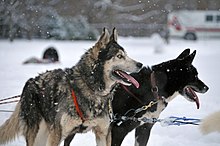It can be fixed......
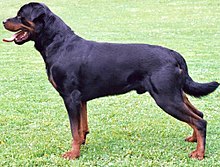 | |||||||||||||||||||||||||||||||||
| Common nicknames | Rott Rottie | ||||||||||||||||||||||||||||||||
|---|---|---|---|---|---|---|---|---|---|---|---|---|---|---|---|---|---|---|---|---|---|---|---|---|---|---|---|---|---|---|---|---|---|
| Origin | Germany | ||||||||||||||||||||||||||||||||
| |||||||||||||||||||||||||||||||||
| |||||||||||||||||||||||||||||||||
| Domestic dog (Canis lupus familiaris) | |||||||||||||||||||||||||||||||||
SO why are there so many canine misfits around these days? If dogs domesticated themselves, if they have evolved their way into a cozy place in human society by instinctively ingratiating themselves, if they have learned behaviors that elicit a friendly response and play on our pre-programmed sympathies, then why are the veterinary journals full of case reports like this one?
The Irish Setter, is a setter, a breed of gundog and family dog. The term Irish Setter is commonly used to encompass the show-bred dog recognised by the American Kennel Club as well as the field-bred Red Setter recognised by the Field Dog Stud Book. 
 Wikipedia
Wikipedia
Life span: 12 – 15 years
Temperament: Lively, Playful, Energetic, Companionable, Affectionate, Independent
Weight: Female: 24–29 kg, Male: 27–32 kg
Colors: Chestnut, Mahogany, Red
An 18-month-old male Irish Setter was owned by a young childless couple. The husband was often threatened by the dog and had been bitten several times. The dog would growl whenever the husband entered the room. This usually occurred if the wife and the dog were in the room before the husband entered.
The dog would willingly go for walks with the husband, but only the wife could be in the kitchen when the dog was eating. The dog was most likely to attack the man when he tried to enter his bedroom if the wife was already there.
 | ||||||||
| Common nicknames | APBT, Pit Bull, Pit | |||||||
|---|---|---|---|---|---|---|---|---|
| Origin | United States, United Kingdom[1] | |||||||
| ||||||||
| ||||||||
| Domestic dog (Canis lupus familiaris) | ||||||||
It is impossible to say for sure if such problems are getting worse, though there is no doubt that aggression in dogs is a widespread phenomenon. In Baltimore, a city of 80,000 to 100,000 dogs, there were 7,000 attacks on people in one year, according to a classic 1973 study.
 | |||||||||||||||||||||||||||||
| Origin | Scotland | ||||||||||||||||||||||||||||
|---|---|---|---|---|---|---|---|---|---|---|---|---|---|---|---|---|---|---|---|---|---|---|---|---|---|---|---|---|---|
| |||||||||||||||||||||||||||||
| |||||||||||||||||||||||||||||
| Domestic dog (Canis lupus familiaris) | |||||||||||||||||||||||||||||
According to the Centers for Disease Control and Prevention, each year in the United States 800,000 people are injured seriously enough by dogs to require medical attention, 6,000 are hospitalized by dog attacks, and about fifteen, mostly children, are killed.
Sorry dog Aggression is of course part of the dog psyche; young dogs, particularly males, do frequently test the dominance status of higher-ranking males. Some other specific behavioral problems reflect innate propensities that have simply become incompatible with modern urban life.
| Look up huskyin Wiktionary, the free dictionary. |
For example, traditional sled-dog breeds show up disproportionately among dogs that experience what the veterinary behaviorist Katherine Houpt, of Cornell, terms "barrier frustration": they like to run and don't like being kept in a confined space -- and respond by chewing or other destructive behavior.
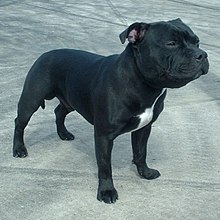 | ||||||||||||||||||||||||||
| Common nicknames | Staffy Staffy Bull Staffy Dog Nanny Dog SBT[1] | |||||||||||||||||||||||||
|---|---|---|---|---|---|---|---|---|---|---|---|---|---|---|---|---|---|---|---|---|---|---|---|---|---|---|
| Origin | England | |||||||||||||||||||||||||
| ||||||||||||||||||||||||||
| ||||||||||||||||||||||||||
| Domestic dog (Canis lupus familiaris) | ||||||||||||||||||||||||||
And of course some dog behavioral problems are owner problems. Because dogs are so good at picking up on social signals, our psychological failings readily affect the way our pets act. A survey of cocker-spaniel owners in
Britain found that less-assertive owners had more-aggressive dogs.
There has been a distinct upsurge in the "yuppie-puppy syndrome," as young working couples buy dogs and leave them alone at home all day to ruin the house -- and then spoil them out of guilt for neglecting them.
There is also a marked tendency, noted by dog breeders and veterinarians alike, for expectations and realities to clash, because members of an increasingly urban society do not always know what they are getting themselves into when they bring a high-energy herding or hunting dog into their lives.
But there are several reasons to think that canine aggression and other behavioral problems as they exist today are not a "normal" part of the evolved relationship. Nor are they merely the result of individual owners' personality traits. Over the course of 100,000 years there should have been a considerable amount of selection (even if it was largely unwitting) against aggressive dogs.
And most people who seek help for behavioral problems with their dogs, Houpt says, have "done all the right things." Feral dogs, significantly, are not very aggressive. Studies of urban dogs found that strays were only a third as likely as owned dogs to exhibit aggression toward people when approached. Most wolves are not really aggressive either. There is only one "alpha," or dominant, male in a pack. Most wolves, and most dogs, are not alpha in the natural scheme of things.
| Gray wolf Temporal range: 0.7–0 Ma Middle Pleistocene – Recent | |
|---|---|
 | |
| Eurasian wolf (Canis lupus lupus). | |
| Scientific classification | |
| Kingdom: | Animalia |
| Phylum: | Chordata |
| Class: | Mammalia |
| Order: | Carnivora |
| Family: | Canidae |
| Subfamily: | Caninae |
| Tribe: | Canini |
| Genus: | Canis |
| Species: | C. lupus |
| Binomial name | |
| Canis lupus Linnaeus, 1758[2] | |
| Subspecies | |
Numerous and disputed, seeSubspecies of Canis lupus
| |
 | |
| Historical (red) and modern (green) range of wild subspecies of C. lupus | |
Many people explain the persistence of canine aggression by pointing to deliberate efforts within certain human subcultures to breed aggressive dogs as status symbols or for protection. But even this cannot completely explain what is going on.
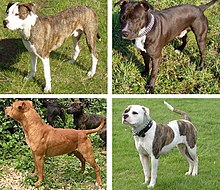
A selection of pit bull type dogs. Clockwise:American Pit Bull Terrier, American Staffordshire Terrier, American Bulldog,Staffordshire Bull Terrier.
| |
| Origin | England Scotland Ireland United States |
|---|---|
| Domestic dog (Canis lupus familiaris) | |
Notoriously aggressive breeds like Dobermans and German shepherds do show up on lists of problem dogs; but according to Houpt's research, so do springer spaniels and cocker spaniels -- and aggression among these, which hardly rank as notoriously aggressive breeds, may be a phenomenon of the past several decades. Among owners of springer spaniels the phenomenon is widely recognized; they call it "springer rage," only slightly tongue-in-cheek. According to a survey by Houpt, 27 percent of springer spaniels had bitten a person -- at least twice the average rate for dogs.
 | |||||||||||||||||||||||||||||
| Other names | Doberman | ||||||||||||||||||||||||||||
|---|---|---|---|---|---|---|---|---|---|---|---|---|---|---|---|---|---|---|---|---|---|---|---|---|---|---|---|---|---|
| Common nicknames | Dobie Dobermann Dobynm | ||||||||||||||||||||||||||||
| Origin | Germany | ||||||||||||||||||||||||||||
| |||||||||||||||||||||||||||||
| |||||||||||||||||||||||||||||
| Domestic dog (Canis lupus familiaris) | |||||||||||||||||||||||||||||
Such streaks of aggression may seem odd, and they are odd. They seem to be traceable quite directly to the way dogs have been bred for the past century. By now nearly everyone has heard about the evils of inbreeding in dogs, and hip dysplasia and other hereditary diseases are forever being cited by animal-rights activists in their campaigns against pet ownership in general and dog breeders in particular.
Such defects are often presented as the inevitable consequence of any attempt by humankind to manipulate or direct the evolution of a species toward characteristics it happens to fancy.
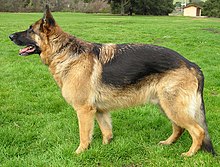 | |||||||||||||||||||||||||||||||||
| Other names | Alsatian (UK) Alsatian wolf dog (UK) Berger Allemand Deutscher Schäferhund Schäferhund | ||||||||||||||||||||||||||||||||
|---|---|---|---|---|---|---|---|---|---|---|---|---|---|---|---|---|---|---|---|---|---|---|---|---|---|---|---|---|---|---|---|---|---|
| Common nicknames | Alsatian, Deutscher Schäferhund, DSH, GSD, Shepherd, Schäferhund | ||||||||||||||||||||||||||||||||
| Origin | Germany | ||||||||||||||||||||||||||||||||
| |||||||||||||||||||||||||||||||||
| |||||||||||||||||||||||||||||||||
| Domestic dog (Canis lupus familiaris) | |||||||||||||||||||||||||||||||||
But genetic markers imply that up until a century or so ago people did successfully develop many highly distinctive varieties of dogs -- everything from lap dogs to attack dogs, bird dogs to sled dogs -- without a loss of overall genetic diversity, and without a rise in physical or behavioral abnormalities.
 | |||||||||||||||||||||||||||||
| Common nicknames | Maltese lion dog | ||||||||||||||||||||||||||||
|---|---|---|---|---|---|---|---|---|---|---|---|---|---|---|---|---|---|---|---|---|---|---|---|---|---|---|---|---|---|
| Origin | Central Mediterranean Area [1] | ||||||||||||||||||||||||||||
| Patronage | Italy [1] | ||||||||||||||||||||||||||||
| |||||||||||||||||||||||||||||
| |||||||||||||||||||||||||||||
| Domestic dog (Canis lupus familiaris) | |||||||||||||||||||||||||||||
The evidence also suggests that the problems that have arisen are less a direct consequence of deliberate breeding practice -- as is usually alleged -- than a largely avoidable side effect of it.
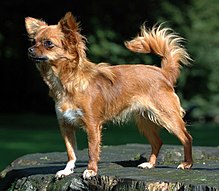
A purebred Chihuahua showing the classic features of the breed
| |||||||||||||||||||||||||||||||||
| Other names | Chihuahua | ||||||||||||||||||||||||||||||||
|---|---|---|---|---|---|---|---|---|---|---|---|---|---|---|---|---|---|---|---|---|---|---|---|---|---|---|---|---|---|---|---|---|---|
| Origin | Mexico | ||||||||||||||||||||||||||||||||
| |||||||||||||||||||||||||||||||||
| |||||||||||||||||||||||||||||||||
| Domestic dog (Canis lupus familiaris) | |||||||||||||||||||||||||||||||||
Historically, dogs were mostly categorized by general type. There were sheep dogs, foxhounds, spaniels, pointers, retrievers. But pointers were just pointers -- they weren't German short-haired pointers or Vizslas or Weimaraners. As Wayne's genetic data show, interbreeding and a flow of genes on a worldwide scale was continuing even as this segregation into types was taking place. The types were distinct in both physical appearance and behavior; they clearly had been selected with specific human aims in mind. But the crucial point is that these dogs were defined by form and function rather than by parentage. They were what livestock breeders would today call "open" or "grade" breeds.
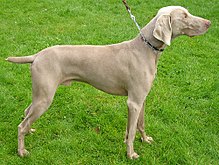
Male Weimaraner with docked tail
| ||||||||||||||||||||||||||
| Other names | Weimaraner Vorstehhund | |||||||||||||||||||||||||
|---|---|---|---|---|---|---|---|---|---|---|---|---|---|---|---|---|---|---|---|---|---|---|---|---|---|---|
| Common nicknames | Weim Grey Ghost | |||||||||||||||||||||||||
| Origin | Germany | |||||||||||||||||||||||||
| ||||||||||||||||||||||||||
| ||||||||||||||||||||||||||
| Domestic dog (Canis lupus familiaris) | ||||||||||||||||||||||||||
The sheer diversity of dog breeds, and the fact that up until a hundred years ago -- a blink of an eye in terms of evolutionary time scales -- genes flowed freely throughout the global dog population, together imply that we still have ample genetic reserves that can be drawn on to undo any damage recently done. Taken as a whole, the genetic diversity of the dog remains as great as that of its wild ancestors.
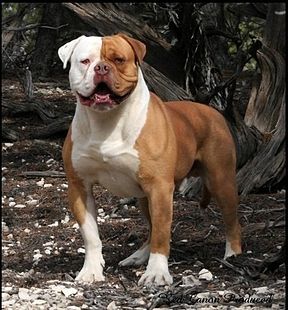 | |||||||||||||||||||||||||||||||||
| Origin | United States of America | ||||||||||||||||||||||||||||||||
|---|---|---|---|---|---|---|---|---|---|---|---|---|---|---|---|---|---|---|---|---|---|---|---|---|---|---|---|---|---|---|---|---|---|
| |||||||||||||||||||||||||||||||||
| |||||||||||||||||||||||||||||||||
| Domestic dog (Canis lupus familiaris) | |||||||||||||||||||||||||||||||||
We can take some reassurance, too, from the fact that mutts, owned and unowned, will always be with us. Despite the efforts of neo-eugenicists to ostracize them, mutts constitute a vibrant reservoir of canine genetic diversity. Mutts tend to be healthy dogs, because of hybrid vigor. They also tend to be good dogs. And in a very real sense mutts today embody the evolutionary heritage of the True Dog -- that animal that evolved with us, that adapted to and exploited our society, and did so largely on his own terms.
The English Springer Spaniel is a breed of gun dog in the Spaniel family traditionally used for flushing and retrieving game. It is an affectionate, excitable breed with an average lifespan of twelve to fourteen years. 
 Wikipedia
Wikipedia
Life span: 12 – 14 years
Temperament: Alert, Cheerful, Active, Attentive, Intelligent, Affectionate
Colors: Orange & White, Liver & White, Tri-color, Red & White, Black & White, Lemon & White
Weight: Female: 18–23 kg, Male: 20–25 kg
Height: Female: 46–51 cm, Male: 48–56 cm
Defiant of human fashion and whim, selected only in accordance with the ancient evolutionary dictate that demands nothing more than an ability to get along with rather gullible human beings, mutts are really what dogs are about. If worst comes to worst, perhaps they will set us straight, just as their ancestors so ably did -- at least for 99,900 of the past 100,000 years.
The online version of this article appears in three parts. Click here to go to parts one and two.
Stephen Budiansky is a correspondent for The Atlantic.
Copyright © 1999 by The Atlantic Monthly Company. All rights reserved.
The Atlantic Monthly; July 1999; The Truth About Dogs - 99.07 (Part Three); Volume 284, No. 1; page 39-53.
http://www.theatlantic.com/past/docs/issues/99jul/9907dogs3.htm
